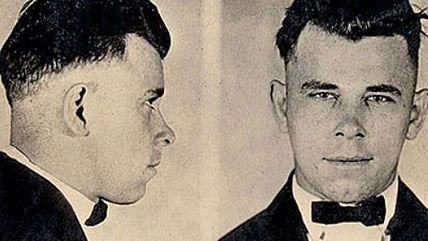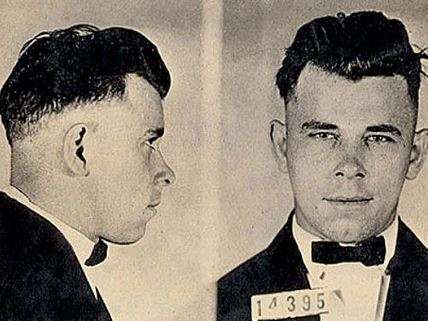Eighty Years Ago Today, John Dillinger Helped Create the FBI


Gangster John Dillinger's lifelong career of crime—he robbed at least 12 banks and four police departments and was accused of shooting and killing an East Chicago police officer while escaping one bank robbery—ended, with his life, eighty years ago today outside the Biograph Theater in Chicago, Illinois. Agents from the Division of Investigation (DOI) of the Justice Department (DOJ), a predecessor to the FBI, surrounded the theater based on a tip from an informant and then shot and killed him when he resisted arrest outside. The FBI's official history explains:
[Special Agent in Charge William] Cowley also phoned [bureau director J. Edgar] Hoover for instructions. Hoover cautioned them to wait outside rather than risk a shooting match inside the crowded theater. Each man was instructed not to unnecessarily endanger himself and was told that if Dillinger offered any resistance, it would be each man for himself.
At 10:30 p.m., Dillinger, with his two female companions on either side, walked out of the theater and turned to his left. As they walked past the doorway in which Purvis was standing, Purvis lit a cigar as a signal for the other men to close in.
Dillinger quickly realized what was happening and acted by instinct. He grabbed a pistol from his right trouser pocket as he ran toward the alley. Five shots were fired from the guns of three FBI agents. Three of the shots hit Dillinger, and he fell face down on the pavement. At 10:50 p.m. on July 22, 1934, John Dillinger was pronounced dead in a little room in the Alexian Brothers Hospital.
The feds avoided a "dynamic entry" and tried to get their man outside the theater. There were no reviews of law enforcement shootings back then, but even a review process that didn't always justify every police shooting would likely find this one justified.
As for that informant, Anna Sage, she was a Romanian immigrant being threatened with deportation as an "alien of low moral character" and provided the government with information hoping it would prevent deportation. Afterward, the FBI told her it didn't have enough influence at the Department of Labor and she was deported anyway, though she did receive $5,000 in reward money. In a 2008 write-up of "spies and snitches," CNN offered a possible "more devious motive" proposed by crime author Jay Nash. Via CNN:
In Jay Robert Nash's book "Dillinger: Dead or Alive," the author suggests the whole episode was a setup. Because the FBI's failure to capture the elusive Public Enemy No.1 was a source of considerable consternation, Nash believes the scene outside the theater that night was the shooting of an innocent man staged by Sage, Zarkovich, and the FBI. The goal? Alleviate pressure on the FBI and help keep the "Lady in Red" in the country.
Sage herself was never reported to have presented a theory like this although as someone kicked out of a country she thought she was helping she likely would've if it were true (and might have even it if weren't).
Nevertheless, the nationally-publicized campaign to capture John Dillinger—he was the feds' first "Public Enemy Number One"—helped bring Hoover and his "G-Men" to prominence. The next year Congress approved the creation of the FBI, an independent DOJ agency. In a column for Roger Ebert where Nash tried to explain his Dillinger theory, he points out:
Hoover personally announced or personally approved of all press announcements on all cases. He totally controlled the public mouth and words of the FBI. To build the image of an invincible Bureau, Hoover relentlessly spent much of his time controlling that public image and manipulating the press-newspapers and radio in those days. He cheated and lied to build that FBI reputation, such as creating out of whole cloth the image and actual words of the "G-Man"; for instance, he issued a statement and reiterated that statement later on in an article for the American Legion magazine that FBI agents captured George "Machine Gun" Kelly in a rooming house and when they burst through the door of his room, Kelly, according to Hoover, stood quaking in his underwear, pleading: "Don't shoot, G-Men, don't shoot!" This was a lie. Kelly was captured by Memphis, Tennessee police detective sergeant William Raney, who slipped into Kelly's bedroom on the night of September 26, 1933, put an automatic to the kidnapper's head and awoke him with a nudge of that cold instrument. Kelly awoke and said: "Well, I've been expecting you fellows." Raney marched him down to Memphis police headquarters where he was booked and then turned over the FBI agents who were waiting at those headquarters-none were present when Kelly was captured and Kelly never said "G-Man" to them or anyone else. That was Hoover's invention. He knew that only local police had the authority to make official arrests before suspects were turned over to his agents to face federal charges--in Kelly's case a kidnapping charge.
The only federal charge ever made against Dillinger was that he drove a stolen car across a state line (the sheriff's car he stole when making his escape from the jail at Crown Point, Indiana and driving it into Illinois), and it was upon that charge alone that Hoover made Dillinger Public Enemy Number One-simply because he was getting more publicity in 1934 than was Hoover and his FBI.
Hoover was director of the FBI from its founding until his death in 1974. He had also been the director of the predecessor agency since 1924. Hoover presided over a bureau that transformed from an agency meant to enforce the anti-prostitution Mann Act and other "interstate commerce" crimes to one that conducted widespread surveillance and counterintelligence operations against various dissident groups in the '60s and '70s.
In a way the FBI was returning, and continues to keep coming back, to its roots. After the assassination of President McKinley by a Polish anarchist, Congress passed a number of laws banning anarchists from entering the country and the feds began to track suspected foreign radicals—it was the first seed of what would become the FBI. Today the agency lists its number one investigative priority as terrorism. According to a Human Rights Watch report, nearly all of the domestic terrorism plots foiled by the FBI were planned by the agency too, in sting operations.
Editor's Note: As of February 29, 2024, commenting privileges on reason.com posts are limited to Reason Plus subscribers. Past commenters are grandfathered in for a temporary period. Subscribe here to preserve your ability to comment. Your Reason Plus subscription also gives you an ad-free version of reason.com, along with full access to the digital edition and archives of Reason magazine. We request that comments be civil and on-topic. We do not moderate or assume any responsibility for comments, which are owned by the readers who post them. Comments do not represent the views of reason.com or Reason Foundation. We reserve the right to delete any comment and ban commenters for any reason at any time. Comments may only be edited within 5 minutes of posting. Report abuses.
Please to post comments




THANKS A LOT, JOHN!
*shakes fist at the sky*
with his two female companions on either side
Obviously he robbed all those banks to get the cash to afford a threesome.. and they killed him right before closing the deal. That is a damnable offense against all the codes of nature and man.
That's the FBI for you: total cock-blockers.
And by "blockers" you mean "suckers"
I thought the movie was pretty good.
Hoover is one of the worst Americans ever.
Well, the way I look at it is to consider him the head of our secret police in the 20th century, and when you compare him to the heads of the NKVD/KGB, Gestapo, Kempeitai, OVRA, etc., he wasn't that bad.
There's an interesting theory that Hoover was black and passing for white. OTOH, the "Hoover in a dress" meme seems to be bullshit invented by some bitter gangster's moll. Hoover may have been gay, but that story seems false.
Are you saying Hoover had a Passing Complexion?
Was J. Edgar Hoover Black?
Yeah? So was the real Lone Ranger:
http://www.crimemuseum.org/blo.....one-ranger
On the other hand, at least he wasn't Canadian.
HEY
I kid!
"eighty years ago today outside the Beacon Theater in Chicago, Illinois"
It was the Biograph was it not?
Yes it was.
I see Ed has fixed it, without acknowledging the original mistake. Must be looking toward working for the NYT.
"Bitch set me up." Famous last words going back to the expulsion from Eden.
Be sure to watch Warren Oates in the awesome movie Dillinger. A great movie, directed by John Milius. Bonus: Milius was the inspiration for the Walter Sobchak character from Lebowski.
Whether Dillinger "grabbed for a pistol"is still controversial. When asked for the weapon that Dillinger had
in his pocket the FBI, which never produced a gun right after the shooting displayed a pistol.The trouble was the pistol the FBI displayed was not even available until a year after Dillingers death.
I think Dillinger was gunned down like Pretty Boy Floyd and Homer Van Meter.
You should also have indicated the innocent bystanders gunned down by the FBI in their abortive raid in
Little Bohemia.
Sound about right for them.
There were no reviews of law enforcement shootings back then, but even a review process that didn't always justify every police shooting would likely find this one justified.
But you're assuming the FBI told the truth about Dillinger grabbing his gun. Remember, there were no dash cams or smart phones in 1934.
Excellent piece, thanks for writing. But the incident which gave the FBI its powers that menace the public even in 2014 was the Kansas City Massacre. Keep up your work on reporting on this evil institution!